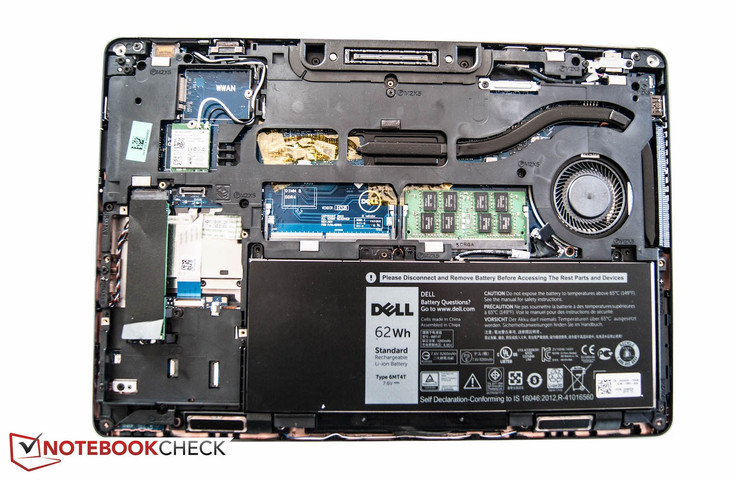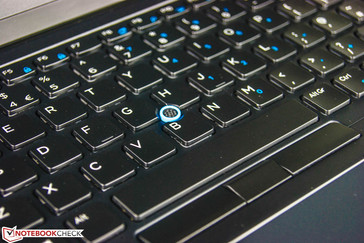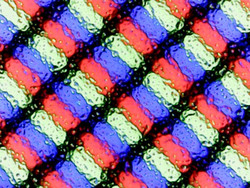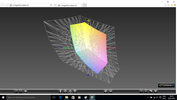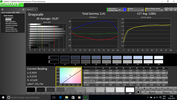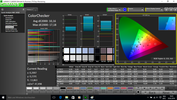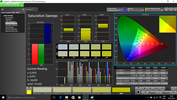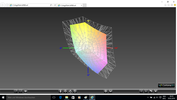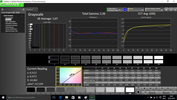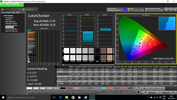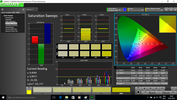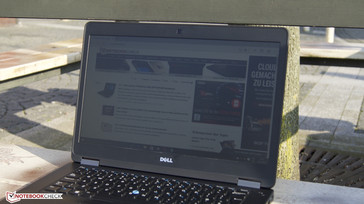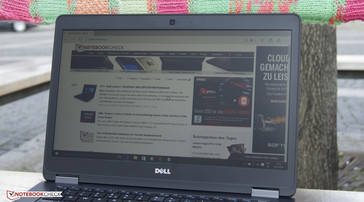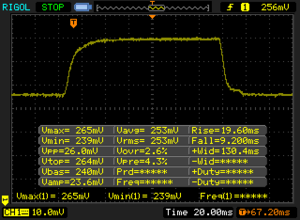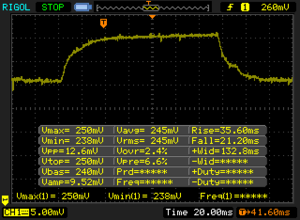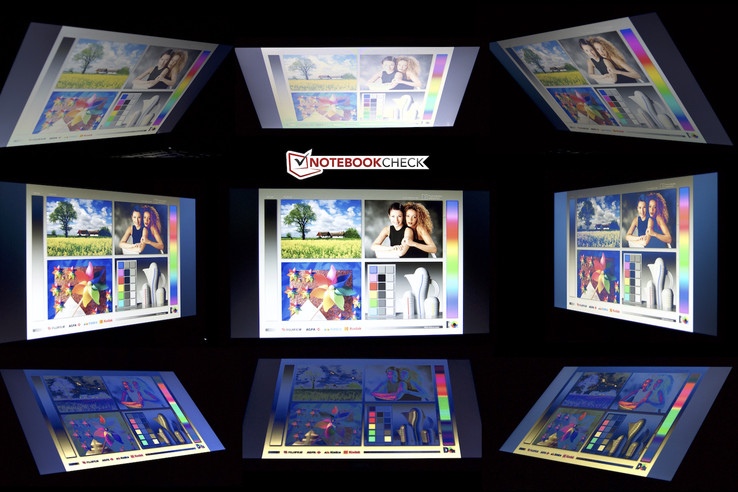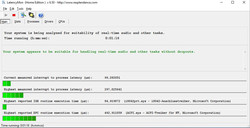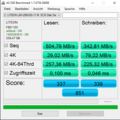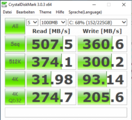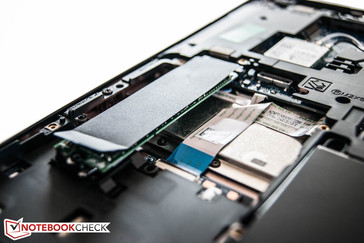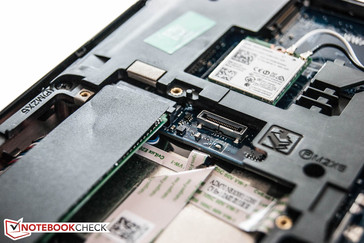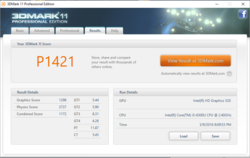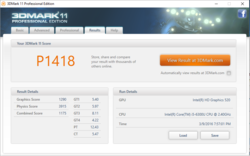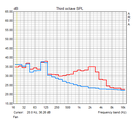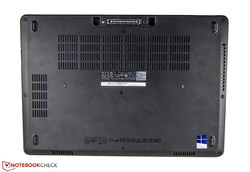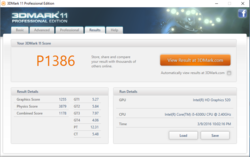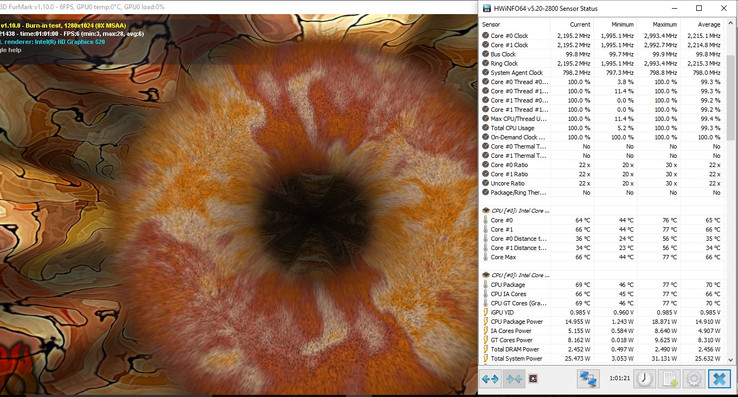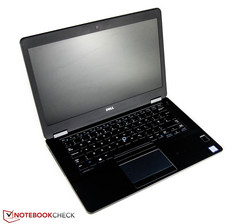Dell Latitude 14 E5470 Notebook Review

For the original German review, see here.
A notebook with optimal performance for business users. Dell uses these words to advertise the new models from the Latitude 14-5000 series. Besides a number of security features, the updated devices now use chips from Intel's latest Skylake generation. Depending on the configuration, Dell charges between 915 and 1,285 Euros (~$1032 and ~$1449). Twelve models for the new Latitude E5470 are available before you can configure it. Our review unit is equipped with an Intel Core i5-6300U, 8 GB DDR4-RAM and a 256 GB SSD. It is a high-end model and is currently available for around 1,250 Euros (~$1409).
Particularly interesting are the differences to the older Haswell generation, so we will also use the Dell Latitude E5450 as well as the less expensive Dell Latitude 3450 as comparison devices. Other rivals are products like the Lenovo ThinkPad T460s or the HP EliteBook 840 G2. The new HP EliteBook 840 G3 is also an alternative and we are currently reviewing it.
Case
The manufacturer follows its usual design philosophy and uses a matte black plastic chassis for the new Latitude. The exception is the dark-silver hinges at the back. Overall, the chassis leaves a simple yet very noble impression. The build quality of the case is satisfying. All edges and corners are carefully rounded, which does create a convenient tactile feel. We could not find any protruding plastic elements or bigger build quality issues even under a closer investigation. The stability of the Latitude is very good; the only exception is the display cover, which can easily be pushed in. The display hinges are much wider compared to the rivals from Lenovo. They are perfectly firm in our case, so there is no display bouncing. However, there are no special certifications according to military standards for the 14-inch business device, which are offered by some rivals.
We can neither find maintenance hatches nor a battery at the bottom of the case. This means you will have to remove the whole bottom cover to gain access to the components.
Compared to the predecessor (1968 g), our review model (1828 grams) is 140 grams lighter, but the thickness of the chassis at around 23 millimeters did not change. Overall, there are only a few changes compared to the predecessor in terms of design and chassis characteristics.
Connectivity
The manufacturer did not change the port layout and distributes all the ports very cleverly at almost all the sides. At the back are the stationary ports (Ethernet, VGA, HDMI, 1x USB 3.0, power), so the space on the desk is not limited. Peripherals like mice can be attached via USB at the side (one on each side). Specialties of the business device are a SmartCard reader, NFC reader, fingerprint scanner and a SIM slot (WWAN module optional and not included). There is no Mini-DisplayPort, so you cannot drive a 4K panel at 60 Hz.
We use our reference card Toshiba Exceria Pro SDXC 64 GB UHS-II to evaluate the performance of the SD-card reader. We copy around 300 JPG pictures (~5 MB each) and can measure high transfer rates of up to 151 MB/s. AS SSD determines sequential transfer rates of 202.95 MB/s (read) and 117.16 MB/s (write) for the card slot.
Communication
There are multiple ways to establish a connection with the World Wide Web. Wireless connections are handled by an Intel Dual Band Wireless-AC 8260 module, but there is also a slot for an optional WWAN module. The additional price for the Qualcomm Snapdragon X7-LTE is 87 Euros (~$98). The maximum transfer rate for the AC 8260 is 867 Mbps (gross). Wired connections are possible via Intel Ethernet Connection I219-LM module with a maximum transfer rate of 1 Gbit/s.
We check the performance of the modules in our individual test environment. We use a Fritz!Box 7490, which is located one floor (3-4 m beeline) below the review unit. The 5 GB file is located on a WD My Cloud and is transferred via the two communication modules. Our test model manages a Wi-Fi transfer rate of 66.2 MB/s and an Ethernet transfer rate of 105 MB/s. An Apple iMac 21.5 (2014) manages around 68 MB/s via Wi-Fi.
A noteworthy option is Intel's Tri-Band Wireless-AC 18260 WiGig, but this module cannot be selected during the configuration yet. The specialty: There will be a Dell Wireless Dock specifically for this module starting winter 2016.
Security
Dell equips its new business device with multiple security features. Our review model sports the optional fingerprint scanner, TPM 2.0, Kensington lock as well as a SmartCard reader and NFC module (FIPS 140-2 Level 3). Another highlight: Dell uses a touch sensor for the fingerprint scanner, which works faster.
There are also many software-based security solutions like Computrace and products from DDP (Dell Data Protection). More details are available on the corresponding product page.
Accessories
The accessories only include a quick-start guide as well as a drivers & utility CD. Docking solutions are particularly interesting for a business device, but there is currently no dedicated docking station for this series. We assume that the docking solutions for the predecessor are compatible. The E/Port Replicator II for the Dell Latitude E5450 retails for 250 Euros (~$282). It will offer more of the already existing ports (USB 3.0, Ethernet etc.) and special ports (serial, parallel, PS/2). More details are available on the corresponding product page.
Maintenance
We already mentioned that there are no maintenance hatches at the bottom, and the battery cannot easily be removed, either. The bottom cover on the other hand can be removed after you loosen eight screws, but you will have to be careful: The small plastic clips can easily break. Maintenance work should therefore be performed by experienced users.
After the removal of the plastic cover, you get access to the memory and hard drive, wireless communication modules, the battery and the fan.
It is pretty simple to upgrade the memory, because only one of the two RAM slots is occupied. A WWAN module can be installed pretty easily as well. It is not possible to use a 2.5-inch hard drive and a thin M.2-SSD simultaneously.
Warranty
Dell grants a one-year warranty with Pro Support and on-site service as well as a three-year basic service. An extension of the Pro Support is possible to three years (120 Euros, ~$135) and four years (192 Euros, ~$216). Another option is the Pro Support Plus, which includes additional services like a 24/7 service and repairs of unintended damages. This service can be purchased for one (30 Euros, ~$33), two (180 Euros, ~$203) or four (270 Euros, ~$304) years. An accidental protection is available for one year and costs 29 Euros (~$32).
Input Devices
Keyboard
Dell uses a matte-black chiclet keyboard with a two-stage illumination for its new Latitude series. All the keys except for the F keys have the same size. They are, however, around 1 mm narrower compared to a current Apple MacBook Pro Retina. The build quality and the stability do not cause any criticism.
The individual keys are slightly concave, which results in a more comfortable typing experience. The travel is pretty soft and could be a bit longer, because fast inputs can feel a bit spongy. All in all, frequent 10-finger writers will still be satisfied with the input. The typing noise is rather muffled in general.
Touchpad
The touchpad is sufficiently sized at 10 x 5.4 cm and is slightly convex, which will feel pretty unusual at first. The stability of the mouse replacement on the other hand leaves a very good impression. Dell uses a slightly roughened surface structure, which allows precise inputs. Even movements in the corners are recognized without problems. Multi-touch gestures are no problem either and are executed smoothly. Below the touchpad are mouse buttons with a long and soft travel. They are slightly rubberized and create a hardly audible clicking sound.
Another mouse replacement is the TrackPoint. It works pretty well, but we still prefer the TrackPoints from Lenovo (e. g. Lenovo ThinkPad T460s) in terms of grip and precision. Above the touchpad are three dedicated buttons. Those mouse buttons do have a conveniently soft travel, but they are a bit louder compared to their touchpad counterparts.
Display
The manufacturer lists four different displays in the spec sheet. However, only two panels are currently available in the German shop. Our configuration of the Latitude E5470 uses a TN panel with 1366x768 pixels. It is the least expensive option, but there is also a brighter Full HD display. The cheapest version with the latter retails for 1,130 Euros (~$1275). We can only hope that the Full HD Touch display with Corning's Gorilla Glass from the spec sheet will be available as well.
We can measure an average luminance of 207 cd/m² for our HD panel. The review model of the predecessor was equipped with a Full HD IPS display, which was about 50 nits brighter.
| |||||||||||||||||||||||||
Brightness Distribution: 80 %
Center on Battery: 226 cd/m²
Contrast: 332:1 (Black: 0.69 cd/m²)
ΔE ColorChecker Calman: 10.16 | ∀{0.5-29.43 Ø4.78}
ΔE Greyscale Calman: 10.87 | ∀{0.09-98 Ø5}
60.4% sRGB (Argyll 1.6.3 3D)
38.4% AdobeRGB 1998 (Argyll 1.6.3 3D)
41.42% AdobeRGB 1998 (Argyll 3D)
60.3% sRGB (Argyll 3D)
40.06% Display P3 (Argyll 3D)
Gamma: 2.41
CCT: 12881 K
| Dell Latitude 14 E5470 TN-Panel 1366x768 | Dell Latitude 14 E5450 IPS-Panel 1920x1080 | Lenovo ThinkPad T460s-20FA003GGE IPS-Panel 2560x1440 | Lenovo ThinkPad T460s-20F9003SGE IPS-Panel 1920x1080 | HP EliteBook 840 G2 TN-Panel 1600x900 | HP EliteBook 840 G3 T9X59ET#ABD HD Graphics 520, 6500U, Samsung SSD PM851 256 GB MZNTE256HMHP | |
|---|---|---|---|---|---|---|
| Display | 62% | 68% | 3% | -3% | 22% | |
| Display P3 Coverage (%) | 40.06 | 66.8 67% | 68.7 71% | 41.65 4% | 38.82 -3% | 48.93 22% |
| sRGB Coverage (%) | 60.3 | 93.2 55% | 98.1 63% | 61.6 2% | 58.4 -3% | 73.7 22% |
| AdobeRGB 1998 Coverage (%) | 41.42 | 68.2 65% | 70.4 70% | 43.14 4% | 40.11 -3% | 50.5 22% |
| Response Times | 18% | 13% | 19% | |||
| Response Time Grey 50% / Grey 80% * (ms) | 56.8 ? | 35.6 ? 37% | 42 ? 26% | 43 ? 24% | ||
| Response Time Black / White * (ms) | 28.8 ? | 29.2 ? -1% | 29.2 ? -1% | 25 ? 13% | ||
| PWM Frequency (Hz) | 220 ? | 204 ? | ||||
| Screen | 64% | 58% | 38% | -4% | 27% | |
| Brightness middle (cd/m²) | 229 | 293 28% | 257 12% | 226 -1% | 267 17% | 366 60% |
| Brightness (cd/m²) | 207 | 271 31% | 248 20% | 211 2% | 240 16% | 336 62% |
| Brightness Distribution (%) | 80 | 85 6% | 94 18% | 89 11% | 84 5% | 87 9% |
| Black Level * (cd/m²) | 0.69 | 0.291 58% | 0.26 62% | 0.22 68% | 0.8 -16% | 0.65 6% |
| Contrast (:1) | 332 | 1007 203% | 988 198% | 1027 209% | 334 1% | 563 70% |
| Colorchecker dE 2000 * | 10.16 | 3.81 62% | 4.59 55% | 6.44 37% | 12.71 -25% | 10.26 -1% |
| Colorchecker dE 2000 max. * | 17.18 | 9.72 43% | 17.18 -0% | |||
| Greyscale dE 2000 * | 10.87 | 3.97 63% | 6.38 41% | 5.87 46% | 13.91 -28% | 11.51 -6% |
| Gamma | 2.41 91% | 2.51 88% | 2.51 88% | 2.37 93% | 2.35 94% | 2.4 92% |
| CCT | 12881 50% | 7368 88% | 6238 104% | 6856 95% | 20099 32% | 12725 51% |
| Color Space (Percent of AdobeRGB 1998) (%) | 38.4 | 60.4 57% | 65 69% | 39.58 3% | 37.2 -3% | 47 22% |
| Color Space (Percent of sRGB) (%) | 60.4 | 98 62% | 61.15 1% | 74 23% | ||
| Total Average (Program / Settings) | 63% /
63% | 48% /
55% | 18% /
27% | -4% /
-4% | 23% /
25% |
* ... smaller is better
A contrast ratio of 332:1 is not convincing and blacks do not appear rich, but grayish. Subjectively, we can see a blue cast, which is confirmed by the CalMAN analysis. Colors deviate quite a lot with a DeltaE of more than 10, but this is not surprising for a TN panel. A calibration can help and will improve the DeltaE deviations of the grayscale to 1.07 and 2.79 for the colors.
The color-space coverage is too low for professional graphics artists at just 60.4% sRGB and 38.4% AdobeRGB.
The matte panel can usually compensate for direct light sources indoors, but the luminance is not high enough to compensate for direct sunlight outdoors. It also looks too dark under indirect sunlight. We recommend places in the shade, where the notebook can be used almost without restrictions.
Display Response Times
| ↔ Response Time Black to White | ||
|---|---|---|
| 28.8 ms ... rise ↗ and fall ↘ combined | ↗ 19.6 ms rise | |
| ↘ 9.2 ms fall | ||
| The screen shows relatively slow response rates in our tests and may be too slow for gamers. In comparison, all tested devices range from 0.1 (minimum) to 240 (maximum) ms. » 75 % of all devices are better. This means that the measured response time is worse than the average of all tested devices (20.2 ms). | ||
| ↔ Response Time 50% Grey to 80% Grey | ||
| 56.8 ms ... rise ↗ and fall ↘ combined | ↗ 35.6 ms rise | |
| ↘ 21.2 ms fall | ||
| The screen shows slow response rates in our tests and will be unsatisfactory for gamers. In comparison, all tested devices range from 0.165 (minimum) to 636 (maximum) ms. » 93 % of all devices are better. This means that the measured response time is worse than the average of all tested devices (31.6 ms). | ||
Screen Flickering / PWM (Pulse-Width Modulation)
| Screen flickering / PWM not detected | ||
In comparison: 53 % of all tested devices do not use PWM to dim the display. If PWM was detected, an average of 8111 (minimum: 5 - maximum: 343500) Hz was measured. | ||
Dell equips our test model with a TN panel, and the viewing angles are very limited. Colors and brightness deviate heavily when you change your position vertically. However, you can usually adjust the display pretty well thanks to the wide opening angle (180 degrees). An IPS panel with wide viewing angles is an optional extra.
Performance
Our test configuration is the most powerful version from the series. A combination of Intel i5 processor, 8 GB DDR4 memory and 256 GB flash storage ensures a responsive system in your business environment. There is even sufficient performance for more complex applications. Unfortunately, the memory operates in a single-channel configuration. Another RAM slot is free, so an additional module could improve the performance (for the GPU in particular).
If you do not need this kind of performance, you can also get a model with an Intel Core i3 processor, 4 GB RAM and a conventional 500 GB hard drive for 915 Euros (~$1033).
The U.S. spec sheet also lists i7 processors (i7 U and H CPUs), but they are currently not available in Germany.
Processor
Heart of our review unit is an Intel Core i5-6300U dual-core processor with a nominal clock of 2.4 GHz. It can reach up to 3 GHz (2 cores up to 2.9 GHz) via Turbo Boost. We use Cinebench R15 to evaluate the CPU performance. We noticed that the CPU could always maintain the full 2.9 GHz over the course of the test, and this does not change even after a couple of runs. A multi-core score of 311 points is on par with similarly equipped notebooks.
The performance is not reduced on battery power according to Cinebench. More comparisons with this processor are available in our benchmark list with modern notebook processors.
| Cinebench R15 | |
| CPU Single 64Bit | |
| HP EliteBook 840 G3 T8X41EA | |
| Lenovo ThinkPad T460s-20FA003GGE | |
| Dell Latitude 14 E5470 | |
| HP EliteBook 840 G3 T9X59ET#ABD | |
| HP EliteBook 840 G2 | |
| Dell Latitude 3450-9723 | |
| Dell Latitude 14 E5450 | |
| CPU Multi 64Bit | |
| Lenovo ThinkPad T460s-20FA003GGE | |
| HP EliteBook 840 G3 T8X41EA | |
| HP EliteBook 840 G3 T9X59ET#ABD | |
| Dell Latitude 14 E5470 | |
| Dell Latitude 14 E5450 | |
| Dell Latitude 3450-9723 | |
| HP EliteBook 840 G2 | |
System Performance
We can summarize the performance of our 14-inch review model as responsive and fast. The fast SSD in combination with the Intel Core i5 processor results in a balanced configuration. This subjective impression is supported by PCMark 7. 5,100 points for the current version is better compared to the predecessor. Only the Lenovo ThinkPad T460s with the more powerful Intel Core i7-6600U is on par with our business device.
| Dell Latitude 14 E5470 HD Graphics 520, 6300U, Liteon L8H-256V2G | Dell Latitude 14 E5450 HD Graphics 4400, 4310U, Lite-On LCS-128L9S | HP EliteBook 840 G2 HD Graphics 5500, 5200U, Samsung SSD PM851 256 GB MZ7TE256HMHP | Lenovo ThinkPad T460s-20FA003GGE HD Graphics 520, 6600U, Samsung SSD SM951a 512GB M.2 PCIe 3.0 x4 NVMe (MZVKV512) | Lenovo ThinkPad T460s-20F9003SGE HD Graphics 520, 6200U, Samsung CM871 MZ7LF192HCGS | |
|---|---|---|---|---|---|
| PCMark 7 | |||||
| Score (Points) | 5125 | 3469 -32% | 4139 -19% | 5190 1% | |
| PCMark 8 | -27% | -16% | 3% | -10% | |
| Home Score Accelerated v2 (Points) | 3438 | 2824 -18% | 2936 -15% | 3542 3% | 3024 -12% |
| Creative Score Accelerated v2 (Points) | 3946 | 3340 -15% | 3139 -20% | 4338 10% | 3644 -8% |
| Work Score Accelerated v2 (Points) | 4599 | 2338 -49% | 4044 -12% | 4442 -3% | 4121 -10% |
| Total Average (Program / Settings) | -30% /
-29% | -18% /
-17% | 2% /
3% | -10% /
-10% |
| PCMark 7 Score | 5125 points | |
| PCMark 8 Home Score Accelerated v2 | 3438 points | |
| PCMark 8 Creative Score Accelerated v2 | 3946 points | |
| PCMark 8 Work Score Accelerated v2 | 4599 points | |
Help | ||
Storage Devices
Our version of the Dell Latitude E5470 uses a 256 GB SSD from LiteOn. This M.2 model is attached via SATA (6 GB/s). Other alternatives are a 500 GB conventional hard drive (7200 rpm) as well as smaller 128 GB SSD.
The flash storage in our review model performs better than the 128 GB drive of the predecessor in terms of sequential read and write operations. The 4K-64 results, however, are much lower compared to the Latitude E5450, so the overall score in the AS SSD benchmark is worse.
Thanks to a fast PCIe drive, the Lenovo ThinkPad T460s beats all the rivals in this section. We measured 2,040 MB/s (seq. read) and 1,407 MB/s (seq. write), which results in a total AS SSD score of 2,439 points.
| Dell Latitude 14 E5470 Liteon L8H-256V2G | Dell Latitude 14 E5450 Lite-On LCS-128L9S | HP EliteBook 840 G2 Samsung SSD PM851 256 GB MZ7TE256HMHP | HP EliteBook 840 G3 T8X41EA Samsung SSD 850 EVO 500GB | Lenovo ThinkPad T460s-20FA003GGE Samsung SSD SM951a 512GB M.2 PCIe 3.0 x4 NVMe (MZVKV512) | Lenovo ThinkPad T460s-20F9003SGE Samsung CM871 MZ7LF192HCGS | |
|---|---|---|---|---|---|---|
| CrystalDiskMark 3.0 | 7% | 9% | 40% | 137% | -59% | |
| Read Seq (MB/s) | 508 | 483.4 -5% | 528 4% | 532 5% | 1778 250% | 446.5 -12% |
| Write Seq (MB/s) | 360.6 | 336.9 -7% | 267.9 -26% | 511 42% | 1530 324% | 171.1 -53% |
| Read 4k (MB/s) | 31.98 | 25.22 -21% | 29.19 -9% | 47.87 50% | 51.3 60% | 5.78 -82% |
| Write 4k (MB/s) | 93.1 | 74.4 -20% | 125.7 35% | 123.8 33% | 139.3 50% | 35.47 -62% |
| Read 4k QD32 (MB/s) | 274.7 | 389.4 42% | 351.1 28% | 393.3 43% | 561 104% | 94.9 -65% |
| Write 4k QD32 (MB/s) | 205.6 | 317.3 54% | 248.1 21% | 346.3 68% | 277 35% | 36.43 -82% |
GPU Performance
Graphics are handled by the Intel HD Graphics 520. This integrated graphics card runs with a core clock between 300 - 1,050 MHz and is based on Intel's current Skylake generation. The most important features include decoding of H.256/HEVC videos and DirectX 12 support.
We can see typical results for this GPU in 3DMark 11. You can improve the performance with a dual-channel memory configuration, which is the case for the Lenovo ThinkPad T460s-20FA003GGE (1,600 points), Asus Zenbook UX303UA (1,569 points) and Acer Aspire R14 (1,584 points). The performance advantage over the predecessor is 44% in 3DMark 11.
The notebook can also utilize the full GPU performance on battery. More benchmarks with the graphics card are available in our Tech section.
| 3DMark 11 - 1280x720 Performance | |
| Lenovo ThinkPad T460s-20FA003GGE | |
| Acer Aspire R14 R5-471T-79GQ | |
| Asus Zenbook UX303UA-R4051T | |
| Dell Latitude 14 E5470 | |
| HP EliteBook 840 G3 T8X41EA | |
| Asus Zenbook UX303UA-FN121T | |
| HP EliteBook 820 G3 T8X20EA | |
| Lenovo ThinkPad T460s-20F9003SGE | |
| Dell Latitude 14 E5450 | |
| 3DMark 11 Performance | 1418 points | |
| 3DMark Ice Storm Standard Score | 50690 points | |
| 3DMark Cloud Gate Standard Score | 5176 points | |
| 3DMark Fire Strike Score | 741 points | |
Help | ||
Gaming Performance
The business notebook was not designed for gaming, but some older classics can actually be played smoothly. Modern games on the other hand will – if at all – only run with the lowest details. More gaming performance is possible with a second memory module. Our model managed 36 fps in BioShock Infinite (Low), which is around 20 % faster than the predecessor. The ThinkPad T460s can reach 55 fps with its dual-channel memory configuration.
More games that can be played with this GPU are listed here.
| BioShock Infinite | |
| 1280x720 Very Low Preset | |
| Lenovo ThinkPad T460s 20FA003FPB | |
| Lenovo ThinkPad T460s-20FA003GGE | |
| HP EliteBook 840 G3 T8X41EA | |
| Dell Latitude 14 E5470 | |
| HP EliteBook 840 G2 | |
| Dell Latitude 14 E5450 | |
| Lenovo ThinkPad T460s-20F9003SGE | |
| 1366x768 Medium Preset | |
| Lenovo ThinkPad T460s 20FA003FPB | |
| Lenovo ThinkPad T460s-20FA003GGE | |
| HP EliteBook 840 G3 T8X41EA | |
| Dell Latitude 14 E5470 | |
| Lenovo ThinkPad T460s-20F9003SGE | |
| HP EliteBook 840 G2 | |
| Dell Latitude 14 E5450 | |
| low | med. | high | ultra | |
|---|---|---|---|---|
| BioShock Infinite (2013) | 36.4 | 21.4 | 17.8 | 5.4 |
| Battlefield 4 (2013) | 34.7 | 24.6 | 14.4 | 4.2 |
| Rise of the Tomb Raider (2016) | 13 | 9.2 |
Emissions
System Noise
The noise development of our review unit is neither inconvenient while idling nor under load. Quite the contrary: The Dell Latitude E5470 convinces with a very quiet cooling solution. It takes a while before the fan starts spinning during our benchmark. We can measure up to 37 dB(A) during our stress test.
Noise level
| Idle |
| 29.2 / 29.2 / 29.2 dB(A) |
| Load |
| 32.1 / 36.8 dB(A) |
 | ||
30 dB silent 40 dB(A) audible 50 dB(A) loud |
||
min: | ||
Temperature
Surface temperatures on the top and the bottom stay below 30 °C while idling. We can only notice an increase to 41 °C under load. Similar to the Latitude E5450, most of the heat is concentrated on the left side. Competitors like the Lenovo ThinkPad T460s are on a similar level.
Next, we want to check the core temperature of the CPU under load. We use the tools FurMark and Prime95 during our stress test. The processor clock will drop 200 MHz below its nominal clock after a couple of minutes, and it rarely drops to 2 GHz. It will level off at 2.2 GHz (nominal clock 2.4 GHz) while the CPU hovers at 65 °C. The old Latitude E5450 only ran with 1.1 GHz (nominal clock 2 GHz) after one hour. Similar to the old model, a 3DMark 11 run immediately after the stress test does not determine a lower score for our review unit.
(±) The maximum temperature on the upper side is 41.5 °C / 107 F, compared to the average of 34.3 °C / 94 F, ranging from 21.2 to 62.5 °C for the class Office.
(±) The bottom heats up to a maximum of 41.4 °C / 107 F, compared to the average of 36.8 °C / 98 F
(+) In idle usage, the average temperature for the upper side is 25.1 °C / 77 F, compared to the device average of 29.5 °C / 85 F.
(+) The palmrests and touchpad are cooler than skin temperature with a maximum of 26 °C / 78.8 F and are therefore cool to the touch.
(±) The average temperature of the palmrest area of similar devices was 27.6 °C / 81.7 F (+1.6 °C / 2.9 F).
Speakers
The speakers can create a decent sound, but it puts too much emphasis on the medium tones. Bass and volume are lacking a bit, but this is not a huge problem. The performance will be sufficient for some YouTube videos or Skype conferences.
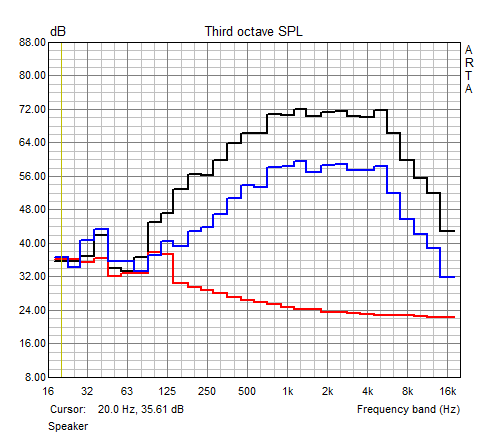
Energy Management
Power Consumption
The idle consumption is (also caused by the simple display) very low at 3.5-6 Watts. For comparison: We measured between 4.5-9.6 Watts for the old Latitude E5450. Our review unit will, however, consume around 3 Watts more than the predecessor under load with up to 36 Watts (drops to around 30 Watts after a short while). On par with our review unit is the Broadwell-based HP EliteBook 840 G2. Much more powerful CPU and GPU result in a much higher consumption for the ThinkPad T460p, because the business device for 1,400 Euros (~$1579) will pull up to 66.7 Watts from the socket. The most powerful version of the ThinkPad T460s series also needs around 10 Watts more thanks to an adjusted TDP (25 instead of 15 Watts).
Our review unit was shipped with a 90-Watt PSU, but production models are supposed to be shipped with 65-Watt modules.
| Off / Standby | |
| Idle | |
| Load |
|
Key:
min: | |
Battery Runtime
Dell equips the new Latitude E5470 with a 62-Wh battery. For comparison: The Latitude E5450 only had a 51-Wh battery. We use three different test scenarios to check the effects on the battery runtime.
We start with the maximum runtime at minimum brightness and simulate the reading of a text document. The review unit will last 21:44 hours and therefore clearly beats the Latitude E5450 (13:14 hours) and the Lenovo ThinkPad T460s (14 hours).
The review unit also manages almost 11 hours in our more realistic Wi-Fi test, so it should easily last even a long business day. The Dell Latitude E5450 (6.5 hours), Lenovo ThinkPad T460s (5.5 hours) and HP EliteBook 840 G2 (7 hours) cannot keep up with this runtime.
We also check the minimum battery runtime with the tool Battery Eater (Classic) and the highest brightness setting. The notebook shuts down after 3 hours and the competition once again falls behind. The ThinkPad T460s only lasts one hour due to the faster components and the predecessor once again follows in second place with 2:12 hours.
| Battery Runtime - WiFi Websurfing | |
| Dell Latitude 14 E5470 | |
| HP EliteBook 840 G2 | |
| Lenovo ThinkPad T460s-20F9003SGE | |
| Lenovo ThinkPad T460s-20FA003GGE | |
Pros
Cons
Verdict
Dell's new Latitude E5000 series leaves a very solid impression in all our test sections. This starts with the chassis, because it is very robust and noble.
There are hardly any build quality issues, but we would like to see maintenance hatches or at least a removable battery for future iterations.
Probably the most important aspects are the input devices. The keyboard provides a good typing experience, but the travel could be longer. The only real problem of our review unit is the TN panel with its limited viewing angles. There is at least an optional Full HD display with a higher luminance. A better panel would improve the rating a bit. The performance of the Latitude is very balanced and we can measure a clear advantage over the predecessor. Our review unit also convinces with great noise characteristics. We also really liked the battery runtimes; the notebook will easily last more than a full business day on battery.
Dell's Latitude E5470 is a successful mainstream business notebook. If you are, however, looking for an office typewriter, you should attach external input devices.
If you want a high-resolution display and a fast PCIe-3.0-SSD, you should consider the Lenovo ThinkPad T460s. The new HP EliteBook 840 G3 with the Skylake generation should also be interesting. Still, you should not forget that the price of the new Latitude E5470 is much lower compared to these rivals.
Dell Latitude 14 E5470
- 03/20/2016 v5 (old)
Nino Ricchizzi

































